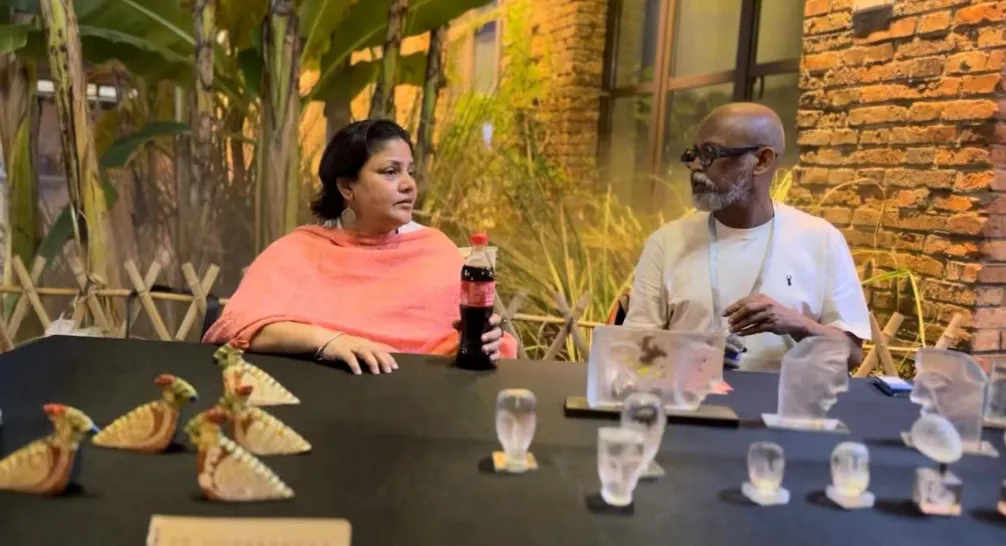'Porcelain capital' Jingdezhen: a window into China's openness and inclusiveness

Tourists visit the Taoxichuan cultural and creative block in Jingdezhen, east China's Jiangxi Province. (Photo by Xiao Benxiang/People's Daily Online)
Jingdezhen, a city known as the world-famous "porcelain capital" in east China's Jiangxi Province, boasts a distinctive charm and artistic ambiance bestowed by its rich traditional ceramic culture.
With over 2,000 years of history in ceramic craftsmanship, the small city has become a window into the openness and inclusiveness of Chinese civilization.
The trading center for the China Jingdezhen International Ceramics Expo is home to nearly 1,000 international ceramic brands, building a global network of ceramics trade. The Taoxichuan Spring & Autumn Art Fair has brought together global artists and artisans for cultural exchanges. The city hosts more than 60,000 "Jingpiaos," or migrants who came to pursue their dreams, with foreigners always seen in workshops, shops, and schools.
Using ceramics as a bridge, Jingdezhen is welcoming visitors from around the world to foster diverse artistic expressions. It has become a dream city for ceramic artists and a refreshing glimpse into Chinese culture.
At the same time, Jingdezhen is rapidly "going global." In 2023, Jingdezhen's official flagship store opened in Dubai, providing a new platform for cultural exchanges and foreign trade for local ceramic companies. Statistics show that since 2013, the average annual growth of Jingdezhen's ceramic export volume has exceeded 20 percent.
For centuries, Jingdezhen's ceramic products have traversed rivers and oceans, making their way from China to the world. The city's global significance is so profound that it was one of the only three Chinese cities noted on the maps of British museums during the 16th century.
Going global - Telling ceramic stories to the world
As China's only national ceramic culture inheritance and innovation pilot zone, Jingdezhen is continuously sharing its ceramic cultural stories with the world.

Photo shows an Indian couple selling their porcelain products at the Taoxichuan Spring & Autumn Art Fair in Jingdezhen, east China's Jiangxi Province. (Photo by Fan Xiaoying)
It has set up international experience centers for ceramic culture in Italy and many other countries, and developed an interactive map together with over 100 museums and archaeological institutions, which allows users to explore the global ceramic landscape with a simple touch.
Beyond Jingdezhen, the Chinese ceramic culture as a whole is revealing its charm through exchanges with different civilizations.
For example, the "Blanc de Chine -- Dehua Porcelain" international exhibition is expected to host cultural exchange activities in more than 20 countries and regions in five years. The crack ice pattern typically found on Longquan celadon ceramics created an important design for the medals of the Beijing Winter Olympics, captivating athletes from around the world.
Ceramics provides a fascinating perspective into the global charm of Chinese culture. In recent years, from traditional festivals to artistic performances and intangible cultural heritage, fine traditional Chinese culture has continuously transcended borders, capturing the affection of people worldwide and strengthening people-to-people bonds through cultural exchanges.
A civilization can flourish only through exchanges and mutual learning with other civilizations.

Allan Denis Naymark from the United States creates ceramic works in his studio in Jingdezhen, east China's Jiangxi Province. (Photo from People's Daily)
Throughout its long history, Jingdezhen has consistently embraced new ideas, experimented with new techniques, and explored new aesthetic expressions.
For instance, the Persian Samarra-blue dazzlingly adorned Jingdezhen's porcelain ware, creating the legendary narrative of blue-and-white ceramics. Many vases have absorbed the design characteristics from other parts of the world, as represented by Meiping vases, moon-shaped vases and double-handled flat vases.
The "Eight Friends of Zhushan," a group of Jingdezhen artisens widely noted for their innovations in porcelain painting, took propelling famille rose porcelain to a new height by integrating Chinese and Western painting techniques.
The openness and inclusiveness have become the crucial secret for Jingdezhen to sustain its kiln fires for a millennium.
Bringing in - Writing captivating stories of opening up
At the Taoxichuan International Studio, an American ceramic artist, who has lived in Jingdezhen for many years, was operating his 3D printer. He has ingeniously integrated painting techniques and cultural elements he had learned in countries like South Korea and Japan into his ceramic designs.
In recent years, Jingdezhen has taken a range of measures to foster a vibrant artistic environment for global ceramics enthusiasts.
It has put forth the Migratory Bird Program to attract international artists for residencies, and extended its entrepreneurial incubation chains to support business startups at different development stages. It has also set up service centers to provide comprehensive support for those who come here to pursue their ceramics dreams.
These efforts have opened new horizons for the ceramic industry, created unprecedented possibilities and enriched the creativity of the city's ceramic culture.
Photos
Related Stories
- Porcelain artisan dedicates himself to innovation, development of Dehua porcelain in Fujian
- Porcelain industry thrives in Dehua county, SE China's Fujian
- Inheritor passes on famille-rose porcelain in E China's Jiangxi
- Feature: China's Jun porcelain: Innovating with IP protection
- Global artists craft dreams in "porcelain capital"
Copyright © 2024 People's Daily Online. All Rights Reserved.









